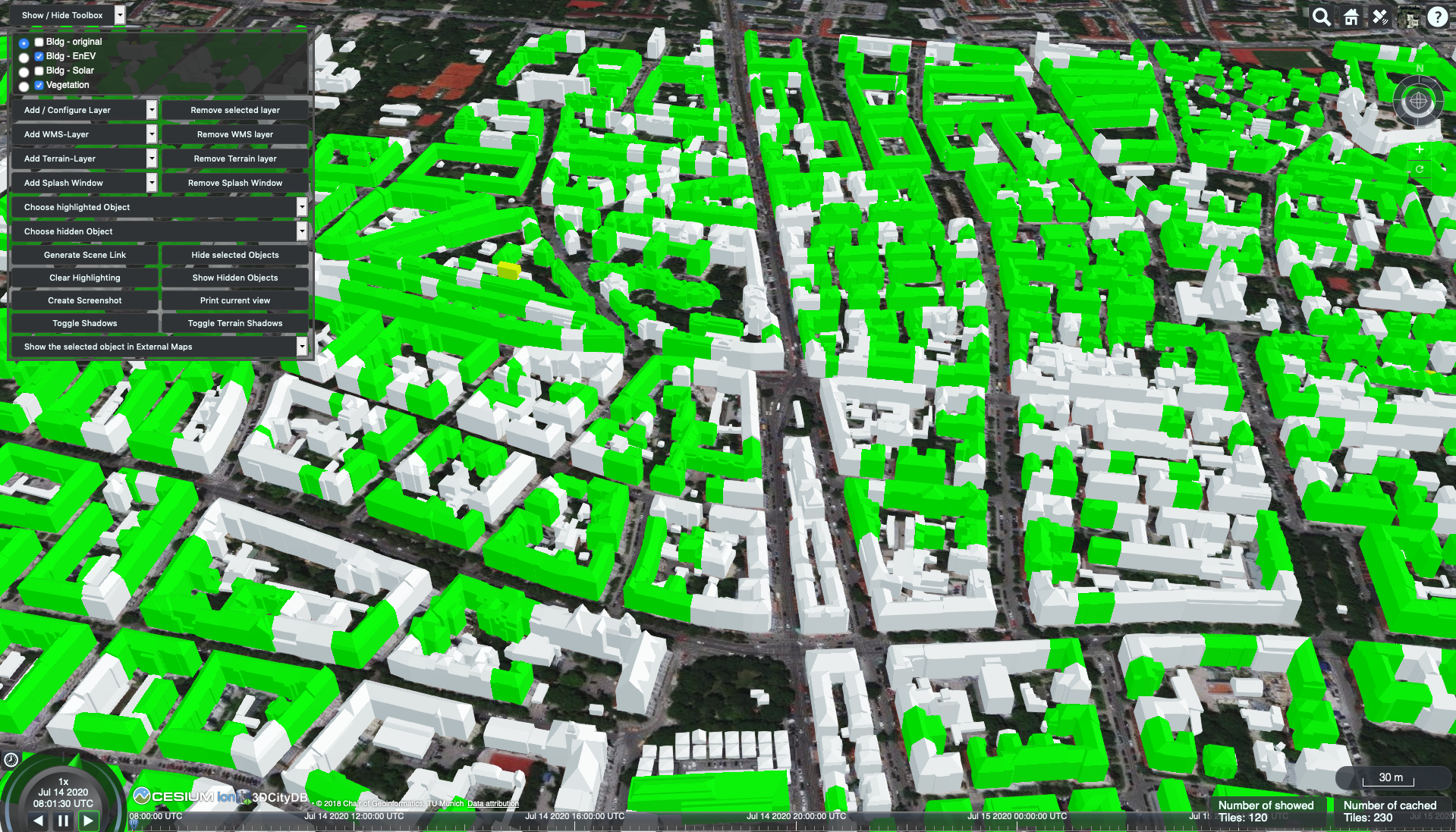Life Cycle Assessment of Technical Building Services of Large Residential Building Stocks Using Semantic 3D City Models
This repository contains the visualisation of the studies result, presented and published at the 3D GeoInfo 2020 conference. The Open Source 3D City Database Web-Map-Client is uses as visualization client.
-
Click HERE to view the online 3D web client demo. Use GoogleChrome for best performance.
-
The full paper is available on MediaTUM and from ISPRS Annals.
The case study shown in the client consists of 115,306 residential buildings in Munich, Germany. All residential buildings are color-coded according to their specific primary energy demand [kWh/m²·a] for the use stage. All non-residential buildings are colored grey. The coloring is done using the color scheme on the energy-related evaluation band of the German energy certificates, according to EnEV (see figure below).
Unit: kWh/m²·a
In addition to the content and results on primary energy demand published in the conference paper, the following further indicators are calculated:
- Primary Energy from non-renewable resources (PENRT) [kWh]
- Primary Energy from renewable resources (PERT) [kWh]
- Heating Load [kW]
- Global Warming Potential (GWP) [kg CO2-eq.]
- Emissions Costs (related to GWP) [€]
- Life Cycle Costs (for the technical building services components) [€]
These indicators result in a multidimensional assessment field that supports important urban planning and policy decision-making processes. The energy demand and heating load calculations can be used, for example, to derive statements on municipal planning for the provision of power plants for district heating. With the emission-related parameters GWP, important aspects of climate change and the highly relevant topic of climate neutrality can be considered and analyzed.
The above-mentioned indicators can be calculated and analyzed for the respective building stock under consideration. The status quo of the building stock can be evaluated, but also any development scenarios. Development scenarios mean that it is possible to define and investigate how the refurbishment of an entire building stock (over a specified period of time) will affect the respective indicators, when assessing them on a life-cycle basis. Among other things, the influence of different building-specific energy supply scenarios, the increasing use of renewable energies, the increases in electricity and construction prices, and the service life of components used can be calculated and assessed.
The results of the development scenarios allow a hypothetical view into the future and enable the fundamental design of urban development processes with a clear focus on sustainable, ecological and affordable solutions.
The results for two scenarios can be selected in the toolbox on the top left. Here, for example, the results for the scenario Status Quo and Scenario 1 can be selected and shown (see following figures). Additionally, a short summary of the general assumptions regarding the calculations are provided. Please refere to the published paper for more detailed information.
- The calculations are based on a single zone model.
- No building specific floor plan or zoning is used for the calculations.
- The energy demand calculation refers to the German Energy Saving Ordinance (EnEV) - DIN V 4108-6 and DIN V 4701-10. Specifically, the heating period procedure is chosen as an approach within DIN V 4108-6 (Heating Period: 185 days).
- A Level-of-Detail 2 CityGML building model is used as input data.
- Basements and underground car parks are excluded.
- Layername: Bldg - original
- The energetic standard of the building, described by U-values, refer to its year of construction.
- Layername: Bldg - EnEv
- The cubature of the buildings does not change, i.e. that there is no increase in height (urban redensification) and that no additional new buildings are added.
- All buildings are refurbished and not demolished and rebuilt.
- The refurbishment of ground, wall and roof surfaces is represented by the improvement of the U-values.
- When refurbishing the TBS components, it is assumed that all components are replaced completely.
The 3D-CityDB-Web-Map-Client is a web-based front-end of the 3DCityDB for high-performance 3D visualization and interactive exploration of arbitrarily large semantic 3D city models in CityGML. It utilizes the Cesium Virtual Globe as its 3D geo-visualization engine based on HTML5 and Web Graphics Library (WebGL) to provide hardware acceleration and cross-platform functionalities like displaying 3D graphic contents on web browsers without the needs of additional plugins.
CityGML is an open data model and XML-based format for the storage and exchange of semantic 3D city models. It is an application schema for the Geography Markup Language version 3.1.1 (GML3), the extendible international standard for spatial data exchange issued by the Open Geospatial Consortium (OGC) and the ISO TC211. The aim of the development of CityGML is to reach a common definition of the basic entities, attributes, and relations of 3D city and landscape models. CityGML is an international standard of the OGC and can be used free of charge.
For further information please contact:
- Hannes Harter - Institute of Energy Efficient and Sustainbale Design and Building, Technical University of Munich
- Bruno Willenborg - Chair of Geoinformatics, Technical University of Munich
We thank the Bavarian State Office for Digitization, Broadband and Surveying (Project: Geomassendaten) for providing the CityGML data as well as the Planning Department of the Bavarian State Capital Munich for providing all other building-specific parameters (e. g. year of construction).


